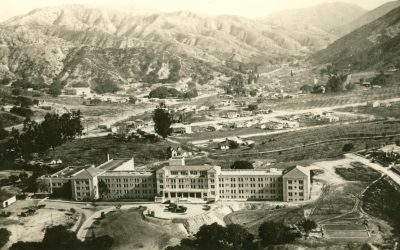Who was J.N. Andrews and How Did He Contribute to Adventism?
John Nevins Andrews (1829–1883) was an influential leader in the early days of the Seventh-day Adventist Church. He was a Bible scholar who helped shape several Adventist beliefs and juggled many leadership roles in the church. Most notably, he was the first official overseas missionary for the Adventist Church outside North America.
Today, his most famous legacy is Andrews University, a college named after him in Berrien Springs, Michigan.
In this post, you’ll learn more about who J.N. Andrews was, his contributions to the Adventist Church, and his roles as a theologian, missionary, and ministerial trainer. We’ll answer the following questions:
- Who was J. N. Andrews?
- What role did he play in forming the Adventist Church?
- What was his significance as a missionary?
- What is his legacy?
Let’s begin with details of his early life.
Who was J.N. Andrews?

J.N. Andrews was born in Poland, Maine on July 22, 1829. But soon after, his family moved to Paris Hill, Maine, where he grew up in a farming community.
His only record of formal schooling is six months of secondary school at age 14. But he had an appetite for learning and was self-taught.
By his late teens, he had a well-trained intellect. He could read several languages and had a broad general knowledge. He also had a good understanding of Latin, Algebra, and English grammar.
His aunt said that Andrews was a “fine, promising boy—a very fine scholar and strictly moral [with] first-rate common sense.”
One of Andrews’ uncles noticed his scholarly potential and offered to pay for Andrews to go to Law School. But by this time, he and his family had become Millerites.
And this religious experience is what led him down the path for the rest of his life.
J.N. Andrews’ conversion and joining the Millerite Movement
John Andrews traced his first religious conviction to the young age of five. That’s when he heard a sermon on Revelation 20:11 at the local Methodist Episcopalian Church.
In 1842, when he was 12, he heard Joshua Himes and other Millerite preachers teach about the Second Advent. This experience led to January 1843, when he said he “found the Savior.”1
 His family and several other Millerite families in the neighborhood joined together to form a congregation.
His family and several other Millerite families in the neighborhood joined together to form a congregation.
Then came the Great Disappointment of October 22, 1844.
It took a while before he could understand the experience. And he struggled to come to terms with the disappointment.
But then, in mid-1845, he read a tract by T. M. Preble, a Seventh Day Baptist, on the sacredness of the seventh-day Sabbath. That helped convince Andrews, and he became a Sabbath keeper at the age of 17. He also became one of the most scholarly defenders of the seventh-day Sabbath as observed by the Adventist Church.
Then in September 1849, Ellen White, James White, and Joseph Bates visited Andrews in Paris Hill.
They shared a new understanding of Daniel 8:14 as explained in O.R.L. Crosier’s paper. They said that “the cleansing of the sanctuary” refers to Jesus’ new work in the heavenly sanctuary, not His return to Earth.
This explained the Millerites’ error which led to the Great Disappointment.
After understanding the new position, Andrews wholeheartedly joined Bates and the Whites in sharing it with other former Millerites.
And at a conference in September 1849, he “felt a call to ministry.” This marked a major turning point in his life.2
From then on, he devoted his entire life and talents to spreading the gospel of Jesus Christ.
But he didn’t do this alone, his family was his great support and encouragement.
His marriage and family
 On October 29, 1856, Andrews married Angeline Stevens (1824–1872). He and another Adventist Pioneer, Uriah Smith, married sisters, Angeline and Harriet Stevens.
On October 29, 1856, Andrews married Angeline Stevens (1824–1872). He and another Adventist Pioneer, Uriah Smith, married sisters, Angeline and Harriet Stevens.
The Stevens and Andrews family were friends in Paris Hill, and by this time, they had both moved to Waukon, Iowa.
John’s first two children were born here: Charles (1857) and Mary (1861).
In 1863, he and his family went to New York, where he had two more children, both of whom died in infancy.
Then sadly, his wife Angeline died from a stroke at age 48, in 1872. In her eulogy, John wrote, “No unkind word ever passed between us, and no vexed feeling ever existed in our hearts.”3
John moved to South Lancaster, Massachusetts, where the children could stay with a family friend.
Andrews never remarried.
But despite all the personal tragedy, J.N. Andrews went on to become a leader in the early days of Adventism.
J.N. Andrews’ role in the early Seventh-day Adventist Church
In October 1849, at age 20, Andrews wrote a letter to James White who was the editor of the Present Truth. And that began his long career as a writer and editor for Adventist publications.
The first Adventist press was set up in Rochester, New York in 1852. Andrews joined James White and Joseph Bates as a member of the publishing committee. He was only 22.
 Just before that, Andrews had begun traveling in the New England area to preach and do pastoral work in 1850. Then, he was ordained as an Adventist preacher in 1853.
Just before that, Andrews had begun traveling in the New England area to preach and do pastoral work in 1850. Then, he was ordained as an Adventist preacher in 1853.
Because of his skill as a writer and a preacher, and because of his great love for study, he made various significant contributions to the Adventist Church. He contributed to the doctrinal understanding, ministerial effort, leadership, and development of church initiatives.
Here are some highlights of his contributions:
Doctrinal contributions
As mentioned earlier, Andrews was an avid scholar. And he used all his intellectual gifts to study the then-young Adventist Church’s beliefs, such as:
Sunset as the beginning of Sabbath: The Church was not settled on when Sabbath should begin. Some said Friday midnight, others Saturday morning, and others Friday at 6 p.m.
 So, he undertook intense research and published a paper in 1855 that said, according to the Bible, sunset marks the beginning of the Sabbath.4
So, he undertook intense research and published a paper in 1855 that said, according to the Bible, sunset marks the beginning of the Sabbath.4
Defending Sabbath’s observance throughout history: In 1861, he published his most prominent book, The History of the Sabbath and the First Day of the Week, which traced the Sabbath throughout history.
Tithing system: He also led a biblical study of systematic benevolence in 1858. It’s what ended up being the Adventist Church’s tithing plan to date.
Health reform: He helped introduce the new health reform ideas to the Adventist community during the early 1860s.5 This was based on his and his son’s experience with health challenges.
He defended Ellen White’s ministry: As editor of the Review, he wrote an article entitled, “Our Use of the Visions of Sr. White.” In it, he showed the place of spiritual gifts in the Church from the Bible. And with that, he supported the ministry of Ellen G. White.6
Prophetic interpretation of Revelation 13: He pointed out the connection between the two-horned beast of Revelation 13 and the United States of America.7
 State of the dead: After the Civil War, Andrews wrote8 on the doctrine of the non-immortality of the soul. This was to help answer questions on life after death and the state of the dead.
State of the dead: After the Civil War, Andrews wrote8 on the doctrine of the non-immortality of the soul. This was to help answer questions on life after death and the state of the dead.
And this wasn’t even all he did. He also held leadership positions and spearheaded various initiatives.
In church leadership and organization
Andrews was generally a dedicated hard worker. And if there was something that needed to be done or a role that needed to be filled, he never hesitated to help out.
He served in several capacities in the church. His positions included:
- Editor of Review and Herald after James White and Uriah Smith (1869–1870)
- Organizer of the denominational publishing house (1860)
- Co-founder of the New York and Minnesota conferences (1862)
- Organizer of the General Conference of Seventh-day Adventists (1863)
- Registrar of the denomination so it could own property legally (1863)
- Creator of the Church organization’s bylaws and constitution (1863)
- Advocate of the non-combatant status for Adventist draftees in the Civil War (1864)
- Third president of the General Conference (1867–1869).
And throughout his years in leadership, he put evangelism at the forefront. Let’s look at that next
In evangelism
 When Adventists decided to have annual evangelistic meetings called “camp meetings,” Andrews hosted the very first one in the Fall of 1868.
When Adventists decided to have annual evangelistic meetings called “camp meetings,” Andrews hosted the very first one in the Fall of 1868.
And he proved to be a very gracious host. It’s reported that every night he went to visit the tents and asked, “Are you all comfortable for the night?”9
Andrews also pioneered new evangelistic methods. For example, he started long-term pastoral mission efforts in some places, instead of the typical two- or three-week evangelistic meetings.10
Eventually, his love for evangelism took him across the oceans as a missionary.
J.N. Andrews as the first Adventist overseas missionary
J.N. Andrews is largely known as the first missionary to be sent overseas by the Adventist Church.
Together with his teenage children, Andrews left New York for Neuchatel, Switzerland in September 1874.
This was in response to calls for a minister to be sent to a group of Sabbath keepers that had come together in Switzerland seven years earlier.
 Besides his excellent scholarship, evangelistic experience, and love for the gospel, he was chosen for this assignment for two reasons:
Besides his excellent scholarship, evangelistic experience, and love for the gospel, he was chosen for this assignment for two reasons:
- He had been corresponding with this group for more than three years and had a significant amount of interaction with them.
- He could read the Bible in French, which was an important language in Europe.
Ellen White was confident of Andrews’ suitability for the task and wrote to church leaders in Europe saying, “We sent you the ablest man in our ranks.“11
He worked to unite the Sabbath-keeping group and organize the mission field.
Then he established an Adventist publishing press in Basel, Switzerland. And started a French evangelistic periodical called Les Signes des Temps. This was the French version of Signs of the Times, which was published back on the American Pacific coast.
In all this, his children were his emotional support and helpers in the printing and publishing work. The family decided to speak only French at home (except for an hour a day). And in a short while, Mary became the copy editor and proofreader for the French periodical.
In the end, Andrews led in efforts to:
- Train leaders and young men for evangelistic outreach
- Establish Basel, Switzerland as the mission base for the rest of Europe
- Convene with the General European Conference at Tramelan (near Basel), Switzerland, along with J. N. Loughborough and other delegates
- Form foundational policies for overseas mission work for the Adventist Church
- Shape and establish the future of Adventist work across national and cultural boundaries by showing the importance of adapting mission efforts to local circumstances
However, due to overwork, inadequate diet, and poor sanitation, John developed pneumonia, and Mary developed tuberculosis.
In the fall of 1878, John went back to North America to attend the General Conference Session. He took Mary with him, in the hopes she could be healed at the Battle Creek Sanitarium. But she died on November 27, 1878.
Heartbroken for the second time, he returned to Europe.
And after nine years of service in Europe, he died in 1883, at the age of 54. His body was buried in Basel, Switzerland.
But even though he died young, he left a telling legacy.
J.N. Andrews’ legacy
J.N. Andrews was a Seventh-day Adventist minister, pioneer missionary, evangelist, writer, editor, and scholar.
It is reported that later in life he was fluent in seven languages and had memorized the whole of the New Testament and parts of the Old Testament.
He had a gifted intellect, which he used to advance Adventist theology and minister to others.
His book History of the Sabbath and the First Day of the Week continues to persuade thousands about the Sabbath truth to this day. And through his writing and evangelism, many found the truth and it continued to nurture the Church in North America, Europe, and North Africa.
To honor his contribution to Adventist scholarship and global mission:
- John Nevins Andrews School in Takoma Park, Maryland was named after him in 1907
- Andrews University in Berrien Springs, Michigan, (formally Emmanuel Missionary College, which was the first institute in Adventist education) was named after him in 1960
- A sculpture of John, Mary, and Charles was unveiled in front of the Andrews University Pioneer Memorial Church in 1993
But beyond his achievements, John N. Andrews left us an example of a life of wholehearted service to God, the church, the community, and the world. In his life, we see zest for the gospel and unwavering love for God.
To learn more about the inspiring lives of other Adventist pioneers and their writings, check out our articles on other Adventist Pioneers.
Want to learn more about Adventists
- James White, “John Nevins Andrews,” The Health Reformer, April 1877, 98.[↵]
- Ellen G. White, Spiritual Gifts II (Battle Creek MI: James White, 1860), 117.[↵]
- “Death of Sister Andrews,” ARH, April 16, 1872, 124.[↵]
- White, Ellen G., Testimonies for the Church, vol. 1, p. 116.[↵]
- The Health Reformer, June 1877, 161; D. E. Robinson, The Story of Our Health Message: The Origin, Character, and Development of Health Education in the Seventh-day Adventist Church, 3rd ed (Nashville: Southern Publishing, 1965); Ronald L. Numbers, 88.[↵]
- Review and Herald, February 15, 1870.[↵]
- Andrews, N. John, “Thoughts on Revelation XIII and XIV” Second Advent Review and Sabbath Herald, Vol. 1, May 19, 1851, pp. 81-85.[↵]
- Pamphlets such as Thoughts for the Candid(1865), Samuel and the Witch of Endor (1866), Departing and Being With Christ (nd), and The Wicked Dead: Are They Now Being Punished? (1865).(1864)[↵]
- Spalding, Arthur W., Origin and History of Seventh-day Adventists, vol. 2, (Review and Herald Publishing Association, 1962), p. 12.[↵]
- J. N. Andrews, “Labors in Maine,” Advent Review and Herald, October 31, 1865, p. 173.[↵]
- White, Manuscript Releases, Vol. 5, p. 436.[↵]
Questions about Adventists? Ask here!
Find answers to your questions about Seventh-day Adventists
More Answers
The Health Benefits of Fresh Air You Should Know About
The Health Benefits of Fresh Air You Should Know About“When you can’t breathe, nothing else matters,” the American Lung Association tells us. And while that’s true, the kind of air you’re breathing will determine the health benefits you experience. Breathing fresh...
What Do Seventh-day Adventists Choose to Eat?
What Do Seventh-day Adventists Choose to Eat?Food blogs overwhelm the internet; food fads are all the rage; and copycat and healthy versions of food are the subject of many a get-together. Eating—and eating the best way—is a big deal. And everybody has a different...
10 Incredible Ways Sunlight Can Improve Your Health
10 Incredible Ways Sunlight Can Improve Your HealthAre you concerned about sunlight’s negative effects? You might be the one who lathers on the sunscreen and covers up when you go outside. Or maybe you avoid being outside as much as possible. You might be surprised,...
Why Is Water So Important?
Why Is Water So Important?We all know that water is a substance we can’t live without. It quenches our thirst and keeps us hydrated on the inside. And it’s necessary for hygiene and cleansing on the outside too. But did you know that the cleansing properties of water...
Ellen White’s Writings and the Adventist Health Message
Seventh-day Adventists are known for their emphasis on healthy living. And Ellen G. White was a significant influence in the development of this priority and practice among Adventists.
Health Clinics
Ellen White and Adventist Healthcare—Ahead of Their Time Medical care in the mid-1800s was primitive, to say the least. Basic concepts we take for granted—such as proper handwashing or recognizing the dangers of bloodletting—were nonexistent. And doctors often had...
What Did Ellen White Teach about Vegetarianism?
What Did Ellen White Teach about Vegetarianism?One thing you might have heard about Seventh-day Adventists is their emphasis on a vegetarian lifestyle. If you’re wondering why that is, it goes back to our church’s humble beginnings: As Adventists studied the Bible,...
How Ellen White’s Teachings Can Improve Your Health
How Ellen White’s Teachings Can Improve Your Health Healthcare in the nineteenth century was said to leave “more disease than it took away” with its use of bloodletting and “medicines” like mercury and arsenic.1 As people questioned these methods, new approaches...
Change Your Perspective on Life with These 5 Mindsets
5 Biblical Mindsets to Change Your Life for the Better Sometimes, life is just plain hard. There’s no way around it. So would thinking about things differently really change anything? Our perspective on life, and everything it throws at us, affects more than we’re...
Bible Promises for When You’re Worried or Fearful
Bible Promises for When You’re Worried or Fearful The Bible is full of beautiful promises that can comfort us in a variety of situations. They can give us hope when we are hopeless, make us feel grateful for God’s love, and comfort us when we’re grieving or suffering....
12 Practical Ways to Overcome Worry
12 Practical Ways to Overcome Worry DISCLAIMER: This content is for informational purposes only. It does not constitute any professional medical advice and is not intended as a substitute for professional mental health therapy. It’s easy to get stuck in a cycle of...
How the Bible Talks About Worry, Fear, and Anxiety
How the Bible Talks About Worry, Fear, and Anxiety Worry and fear are the ingredients of anxiety. It’s easy to see how the world isn’t perfect—and the anticipation of a bad event or experience (that may or may not even happen) can end up draining the peace and...
How to Calm Anxious Thoughts, Using the Bible
How to Calm Anxious Thoughts, Using the Bible You were expecting a phone call from your daughter half an hour ago, and she still hasn’t called. She’s also not answering your calls. You feel your heart thumping as your thoughts race: What if she’s been in a car...
What You Should Know About the Adventist Health Studies
What You Should Know About the Adventist Health StudiesYou may have heard that Seventh-day Adventists care about health. But what you may not know is that Adventists have been the subjects of long-term research into lifestyle and health. Since 1958, researchers from...
Benefits of Sunlight
Yes, There Are Health Benefits of SunlightDespite the bad reputation it’s gotten, sunlight is generally associated with positivity, as shown by songs like “You Are My Sunshine,” or phrases that refer to delightful people as having a “sunny disposition.” There’s a...
Why Your Body Needs Rest for Optimal Health
Why Your Body Needs Rest for Optimal HealthStruggling to think straight? Wondering why you can’t remember that important tidbit you heard earlier today? Feeling like your emotions are about to explode? These are just some of the symptoms that can reveal your need for...
The Seventh-day Adventist Diet: One of Our Key Longevity Secrets
The Seventh-day Adventist Diet: One of Our Key Longevity SecretsOats, avocados, lentils, tofu—probably not what you first think of in a standard American diet. But if you show up at the home of an Adventist, chances are you may be served one of these staples. Out of a...
Why You Need Fresh Air
Why You Need Fresh Air“When you can’t breathe, nothing else matters,” the American Lung Association tells us. We couldn’t agree more! Breathing in clean air is an essential part of caring for our bodies, which God has given us. Together with other health principles,...
Sabbath Meal
Everything You Need to Know About Sabbath MealsFor Seventh-day Adventists, sharing a Sabbath meal with friends and family is one of the most special and memorable parts of the Sabbath. That’s why we want to share with you all about Sabbath meals and why they’re such a...
Adventists and Healthy Living
Adventists and Healthy LivingWhat’s the Adventist “Health Message” All About? One thing Seventh-day Adventists are known for is their emphasis on living healthy lives. Since our bodies are living temples of the Holy Spirit (1 Corinthians 6:19, 20), we strive to stay...
Water’s Importance—Physical Benefits and Spiritual Applications
Water’s Importance—Physical Benefits and Spiritual Applications We all know that water is a substance we can’t live without. Not only does it quench our thirst and keep us hydrated from the inside, but it’s necessary for hygiene and cleansing on the outside as well....
How Important is a “Day of Rest?”
How Important is a “Day of Rest?” Why God Created a Day for Downtime by Martin Casper Do you ever experience the feeling of complete overload? Do you feel like the only way you can get ahead is by slamming it 24/7? I hear these types of comments more and more...
7 Reasons Why a Day of Rest is Important
7 Reasons Why a Day of Rest is ImportantWe live in a fast-paced world. It seems as if success is measured in how much you can do in a short amount of time. (Extra points for the service or product that is available 24/7). The idea that we will be more successful if we...
How do Adventists choose what to eat?
How do Adventists choose what to eat?Every day, parents go through the ritual of getting their kids to eat what is healthy and good while trying to steer them away from what can hinder the growth of their developing bodies. Nutritionists work with their clients to...
How Can I Have a Better Marriage?
Is it possible to have a happy marriage?
How do Adventists make movie and music choices?
How do Adventists make movie and music choices?Cinema has come a long way since the first clips of motion pictures came to light in 1878. As the decades rolled on, film and music producers have created rivers of movies and albums for the masses. Today, watching movies...
Why are many Adventists Vegetarian?
Why are many Adventists Vegetarian?The diet intended for man is outlined in Genesis 1:29, “And God said, ‘See, I have given you every herb that yields seed which is on the face of all the earth, and every tree whose fruit yields seed; to you it shall be for food.’”...
Didn’t find your answer? Ask us!
We understand your concern of having questions but not knowing who to ask—we’ve felt it ourselves. When you’re ready to learn more about Adventists, send us a question! We know a thing or two about Adventists.























